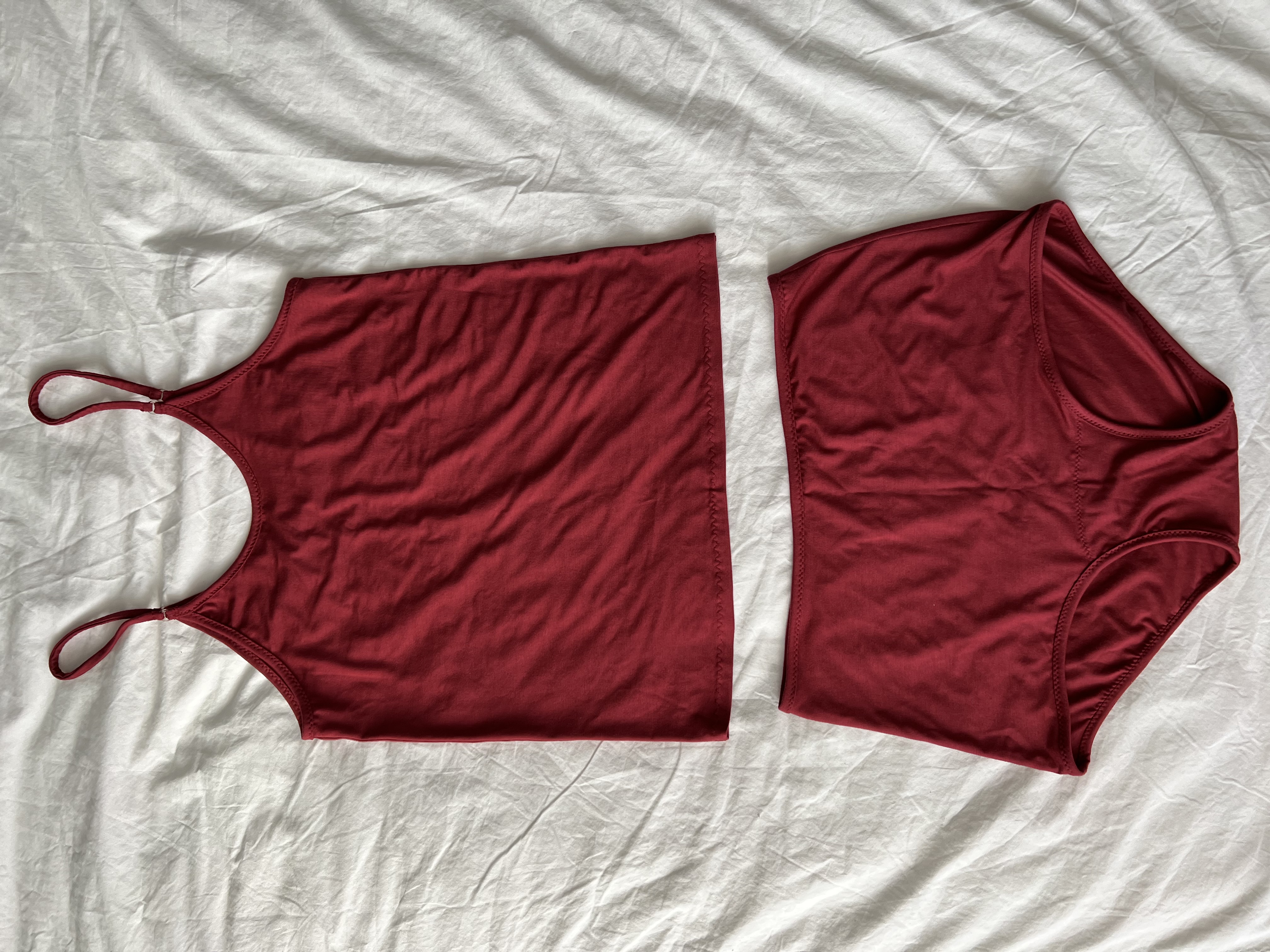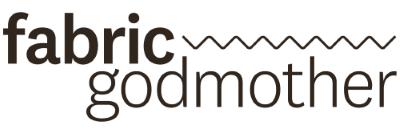Welcome to your January 2022 Dream Wardrobe.
UK SIZES 6-30
What better time than the New Year to try and learn a new skill! It’s cold outside and our calendars seems strangely empty after the buzz of the holidays. So theoretically, we should have more space in our lives to set aside some time and enjoy a new sewing project. This month I've set you the challenge to sew your own underwear.
For those of you who have never sewn your own underwear this month’s box is going to be a life changer. The pattern is a simple tank top and briefs, and the fabric is a butter soft Tencel Modal jersey. For anybody who is new to sewing with jersey this fabric may be more of a challenge for you. But don’t worry, as always, Julia has sewn up a sample and has written a simple step by step guide to sewing with this fabric. Also, this month’s gift will be really helpful when it comes to making this set.
About the fabric:
As I mentioned this month’s fabric is a Tencel modal jersey. For those of you who do not know what Tencel is, here's some info: Tencel is a brand name for Lyocell, a yarn made from Beech wood pulp. If the fabric is branded Tencel it means that the fibres can be traced back to the sustainable forests in Austria where it is grown. I've chosen a selection of my favourite colours for this fabric.
Lyocell is known for breathability, moisture wicking properties and softness next to the skin. Making it the perfect fabric for underwear. This jersey has added elastane to make sure it will move with you.
You have been given 2.5m of Tencel jersey and here are some other ideas of patterns that would work well for this fabric:
True Bias Nova Jumpsuit UK 18-34
True Bias Nova Jumpsuit UK 4-22
Cashmerette Pembroke Dress & Tunic UK 12-28
Christine Haynes Rumi Tank & Dress UK 4-32
I always recommend that you pre-wash your fabric. This is especially important with fabrics that are made from natural fibres (cotton, linen, viscose etc) as these have more of a tendency to shrink. Also, they are more likely to have a dressing added at the factory that can change the feel and handle of the fabric once washed.
Make sure the fabric is unfolded, place in the drum and wash at 30c. Once finished, take the fabric out of the machine straight away and hang it up to dry.
About the pattern:
The Dune Tank and Briefs are a great introduction to sewing your own underwear. This simple set will feel amazing in the Tencel modal jersey, perfect for layering in cold weather. Or for lounging and sleeping in warmer months. Cute O rings attach the straps and the briefs feature a super comfy no elastic waistband. If you like your briefs with a little less coverage them I can highly recommend this FREE undies pattern from So, Zo... what do you know?
You could also use the following fabrics for this set.
Pointelle Cotton Jersey - Chartreuse(For the tank only as it doesn’t have enough 4 way stretch for the briefs pattern)
Modal French Terry - Mustard (For a thicker version)
Organic Cotton Jersey - Seafoam
Notions required:
I know that finding underwear notions can be tricky, so we have included the rings required for this pattern in this month’s box.
- Matching thread (supplied)
- O Rings (supplied)
- Elastic for the straps.
About your gift:
These mini clips are brilliant for projects where pins just won’t cut it. They are perfect for small areas (like tank top straps) where pins may distort the lay of the fabric. Also great for delicate fabrics that you don’t want pin holes in. Flat on the bottom to slide easily into your sewing machine these handy helpers will become a staple in your sewing box.
#fgdreamwardrobe
Please use the hashtag #fgdreamwardrobe and share your unboxing and makes on social media.
Happy sewing, Josie xxx

Dune Tank and Briefs Julia's Sewing Notes
Christine Haynes has a fantastic sewalong for this project on her blog at https://christinehaynes.com/dune-tank-briefs-sewalong which takes you step by step though the construction process.
Fabric
I didn’t pre-wash this fabric – although you ‘should’ pre-wash knitted fabrics I decided that this was so super stretchy that any shrinkage in the wash wouldn’t be noticed. The suggested washing instructions are to machine wash at 30 degrees and don’t tumble dry.
Ironing
I used a medium / cool iron on this fabric to press the side seams, hem and crotch seam. Although the instructions ask you to press the binding, I just finger pressed these and then used clips to hold the binding in place.
Cutting Out
There is plenty of sizing information for body measurements and finished garment measurements, so the correct size can be easily selected. I didn’t make any alterations to the pattern.
When using slippery stretch fabrics, I use a cutting mat, pattern weights and a rotary cutter. I also find it much easier to cut the fabric out as one whole piece through a single layer of fabric, rather than trying to cut out pieces on the fold, so I traced off the front and back pieces for the tank and briefs to create full size pattern pieces and avoid the need to cut on the fold.
When cutting out the straight pieces for the straps and binding lengths I used a ruler and rotary cutter for more accuracy.
The fabric rolls on the edges a lot – you may wish to cut the binding lengths parallel to the selvedge to alleviate this a little – the fabric will still stretch enough when cut in this direction.
There is a definite right and wrong side to this fabric – the right side is the one with more visible texture or lines running down the fabric, parallel to the selvedge.
Transferring pattern markings
Be careful when transferring the markings from the pattern to the fabric to cut the smallest notches as the seam allowance is either 1cm (3/8”) for the side seams or 6mm (1/4”) where the binding is applied.
Making up the garment
I used a size 80/12 ball point/jersey needle on my sewing machine. Test on a scrap piece of fabric to make sure this works for your machine without leaving any skipped stitches. You may find that a stretch needle works better for you, or a needle of a smaller size.
I used a sewing machine and overlocker (serger) to create the samples for Josie, but you could construct the project using only the sewing machine and a combination of narrow, wide and 3-step zig-zag stitches. The pattern instructions give lots of details about suitable stitches to use.
I’ll be making another sample for myself using a coverstitch machine for binding and hemming. I’ll post more details on my blog at www.houseofmisssew.com.
I used a walking foot on my sewing machine to help feed the fabric through the machine evenly.
Run a test on your overlocker to check the settings. I adjusted the stitch length to 3.2 and the differential feed to 1.4 to avoid wavy hems. If you find the fabric doesn’t feed into the overlocker correctly at the beginning of a seam, try turning up the differential feed to the highest number for the first 4-5 stitches or use a wash away stabiliser under the fabric and simply wash this off after constructing.
To make sure the seam allowance is correct, machine tack (baste) the seams first using the correct seam allowance before overlocking, this way you can stitch over the tacking line, positioning the left needle of the overlocker on this line, or slightly to the left of it. You can leave the tacking stitches in the fabric or pull these out to enable greater stretch.
I also hand tacked (basted) the bindings in place before stitching them with a zig zag stitch on the sewing machine.
Attaching the O rings is a little fiddly. I used one long pin to hold the binding in place to secure the O ring and then used another pin to help feed the fabric under the presser foot. After stitching the binding in place, I trimmed off the excess fabric to give a neater finish.
I stitched my straps a little differently than the instructions suggested. I folded the fabric strip with right sides together and stitched the seam using a 1cm seam allowance. I then applied swimwear elastic to this seam (I prefer this to clear elastic as it doesn’t stick to the presser foot) and overlocked this in place before turning the strap right side out. I omitted the topstitching on the strap and attached the straps as per the instructions. I show more details on making the straps over on my blog.
I prefer the look of a 3-step zig-zag for hemming so I used this for the lower edge of the tank. I found it worked best to stretch the fabric a little as I was sewing it to avoid puckering.
You can find more tips and videos of various sewing techniques on my YouTube channel ‘House of Miss Sew’ or on my blog.
